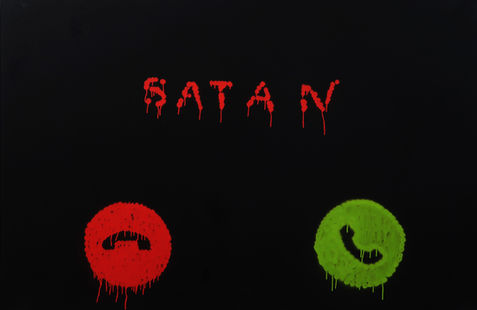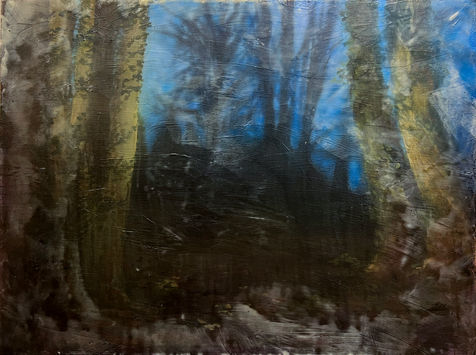Plan X Milan
22 May - 26 June 2025
Kyler Garrison - Pascal Möhlmann - Lucien Murat - Mateusz Sarzynski - Noper - Julius Hofmann
THE DEMONS ARE US

What happens when we stop thinking of “demons” as external forces and begin to recognize them as part of ourselves? Not supernatural entities or symbols of Evil, but inner fragments: ambiguous desires, layered fears, emotions that remain unspoken in everyday life. The Demons Are Us begins with this reversal: what if it’s our own ghosts that speak to us most truthfully? The exhibition unfolds as a dialogue between two radically different approaches to the representation of unease.
On one side, Pascal Möhlmann, Julius Hofmann, and Mateusz Sarzynski confront the demon as body: they represent it, deform it, scream it. Their works are saturated with gestures, symbols, flesh, rituals—staging a visceral conflict between order and chaos, beauty and distortion.
On the other, Kyler Garrison, Noper, and Lucien Murat explore the demon in more diffuse, perceptual forms. In their works, the human figure dissolves or disappears entirely, replaced by emotional landscapes, fragments of memory, or scenarios where chaos has no face but a presence. For them, the demon is a latent tension, a deep vibration, a disorder that does not appear—but is felt. In this friction between saturation and subtraction, between scream and silence, emerges the emotional and perceptual field that runs through The Demons Are Us: an unstable topography, inhabited by visions that seek not catharsis, but confrontation. The vibrant, dense painting of Pascal Möhlmann, with its convulsed figures immersed in pulsing flesh, transforms the classical scene into a battleground of emotion. Intertwined bodies, broken gestures, disturbing gazes: each canvas is a threshold between attraction and repulsion, between form and rupture.
If Möhlmann explores the tension between pictorial order and inner turmoil, Julius Hofmann pushes theatricality to the edge, through a hybrid and hyperbolic visual language. His demonic figures—drawn from video games, metal iconography, and expressionist distortion—inhabit a mental theater charged with irony, obsession, and delirium. In each work, violence merges with play, the sacred with the trashy.
The tone becomes even more direct and symbolic in Mateusz Sarzynski’s paintings, where the demon takes the form of ritual signs, pentagrams, dark dances, and defiled pop icons. His painting is brutal, exaggerated, almost childlike in its over-the-top theatricality. Sarzynski doesn’t celebrate the occult; he empties it, exposing how fear itself can become grotesque, even familiar. In these three cases, the demon is visible, shouted, embodied. Elsewhere, it dissolves, fragments, and disperses.
Noper abandons the human figure altogether, making space for an apocalyptic vision of nature. His video is a visual loop of fire, water, and matter in constant motion, evoking a world where environmental catastrophe is not a future threat, but a present condition. Here, the demon has no face: it is the consequence of our actions, a mute, unstoppable force that surrounds us. Lucien Murat moves in a parallel direction, constructing layered, disorienting universes. His works—filled with visual, textile, and material references—resemble relics of a collective psyche in overload. Nothing is linear; everything is connected in a chaos with no center, no logic. The demon, here, is a scrambled code, a runaway vision. Kyler Garrison, finally, chooses the quietest path. His ambiguous, translucent figures seem to emerge from a suspended inner space, like dreams or memories that cannot quite be grasped. His works speak of absence, of a subtle vibration, of what remains when everything else has already faded.
The Demons Are Us offers no answers or resolutions. It moves through the uncomfortable territory of ambiguity, where identity is no longer coherent but layered and contradictory. In an age that rewards clarity and simplification, this exhibition defends the right to disorder, to complexity, to the gray zones of being. Because looking at our demons doesn’t mean banishing them. It means recognizing them. And perhaps, learning to live with them.














